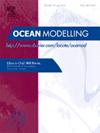Three-dimensional structure reconstruction of ocean mesoscale eddies based on physical process modeling and data-driven machine learning
IF 2.9
3区 地球科学
Q2 METEOROLOGY & ATMOSPHERIC SCIENCES
引用次数: 0
Abstract
To address the challenge of obtaining ocean mesoscale eddies' refined three-dimensional (3D) structure, we propose a novel 3D structure reconstruction model that combines physical process models with data-driven machine learning. First, based on the universal structure of mesoscale eddies, the 3D density structure of eddies is reconstructed using satellite observations and individual Argo profile observations. These eddy density profiles, along with eddy elements (polarity, eddy center, and radius) and sea surface elements (temperature, salinity, and dynamic height), serve as input data to construct a data-driven machine learning algorithm, which can reconstruct the 3D temperature and salinity structure of the eddies. Using observations of oceanic mesoscale cyclonic and anticyclonic eddies in the northwest Pacific Ocean, we demonstrate that both types of eddies' reconstructed temperature, salinity, and density structures align well with the observations. The root mean square errors (RMSEs) for the anticyclonic eddy are 0.361 °C, 0.0271 PSU, and 0.0570 kg/m3, and for the cyclonic eddy, they are 0.372 °C, 0.0904 PSU, and 0.144 kg/m3, respectively. The correlation coefficients exceed 0.98. Compared to multi-source fusion data (ARMOR 3D) and dynamical statistics data (MODAS), the reconstructed 3D structure from this study shows the closest alignment with observed structures. Furthermore, incorporating physical process model inputs significantly enhances the accuracy of the data-driven machine learning reconstruction of the eddy thermohaline structure, reducing the RMSEs by >40 % and 60 %, respectively.
基于物理过程建模和数据驱动机器学习的海洋中尺度涡旋三维结构重建
为了解决获取海洋中尺度漩涡精细三维结构的挑战,我们提出了一种将物理过程模型与数据驱动的机器学习相结合的新型三维结构重建模型。首先,在中尺度涡旋普遍结构的基础上,利用卫星观测和Argo剖面观测资料重建涡旋三维密度结构;这些涡旋密度剖面与涡旋要素(极性、涡旋中心和半径)和海面要素(温度、盐度和动态高度)作为输入数据,构建数据驱动的机器学习算法,重建涡旋的三维温度和盐度结构。通过对西北太平洋海洋中尺度气旋和反气旋涡旋的观测,我们证明了这两种涡旋重建的温度、盐度和密度结构与观测结果很好地吻合。反气旋涡旋的均方根误差(rmse)分别为0.361°C、0.0271 PSU和0.0570 kg/m3,气旋涡旋的均方根误差分别为0.372°C、0.0904 PSU和0.144 kg/m3。相关系数大于0.98。与多源融合数据(ARMOR 3D)和动态统计数据(MODAS)相比,本研究重建的三维结构与观测结构最接近。此外,纳入物理过程模型的输入显著提高了数据驱动的机器学习重建涡旋温盐结构的准确性,将均方根误差分别降低了40%和60%。
本文章由计算机程序翻译,如有差异,请以英文原文为准。
求助全文
约1分钟内获得全文
求助全文
来源期刊

Ocean Modelling
地学-海洋学
CiteScore
5.50
自引率
9.40%
发文量
86
审稿时长
19.6 weeks
期刊介绍:
The main objective of Ocean Modelling is to provide rapid communication between those interested in ocean modelling, whether through direct observation, or through analytical, numerical or laboratory models, and including interactions between physical and biogeochemical or biological phenomena. Because of the intimate links between ocean and atmosphere, involvement of scientists interested in influences of either medium on the other is welcome. The journal has a wide scope and includes ocean-atmosphere interaction in various forms as well as pure ocean results. In addition to primary peer-reviewed papers, the journal provides review papers, preliminary communications, and discussions.
 求助内容:
求助内容: 应助结果提醒方式:
应助结果提醒方式:


